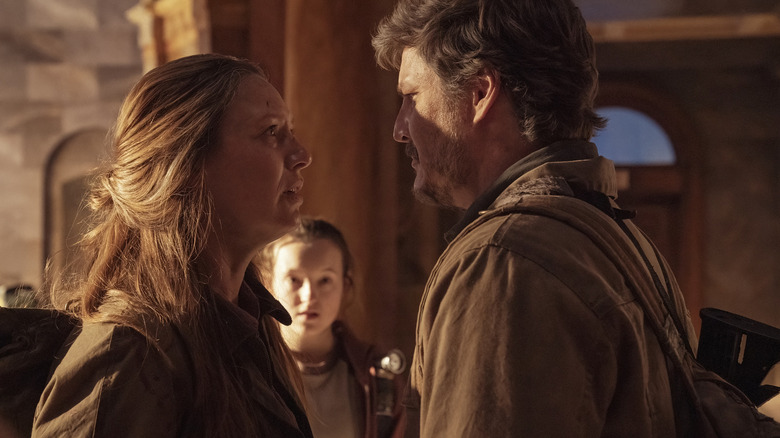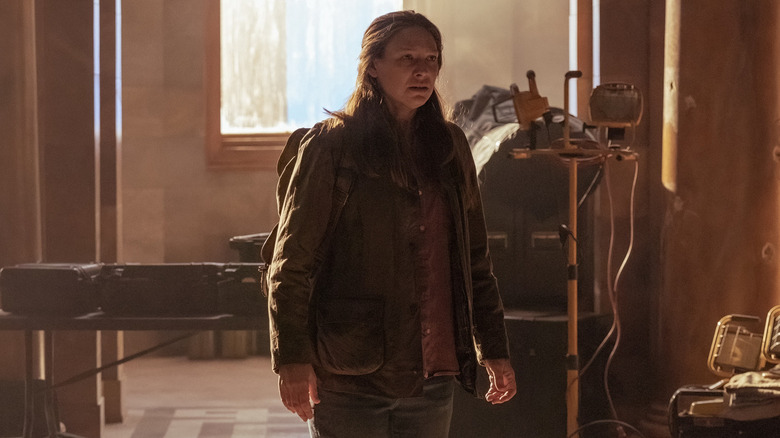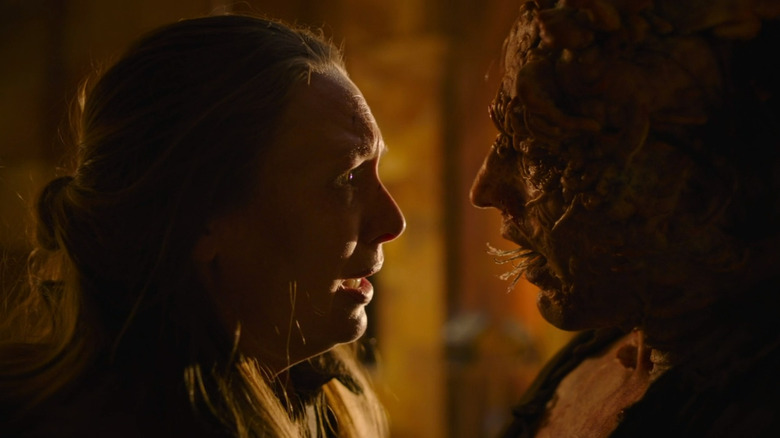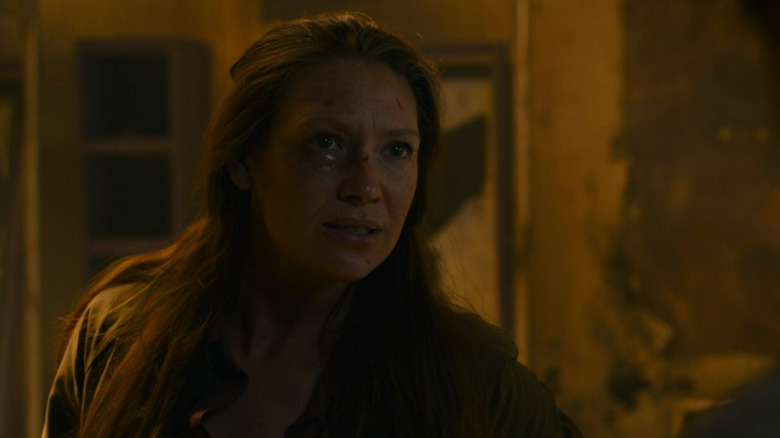Let's Talk About That Big 'Kissing' Scene From The Last Of Us Episode 2
This article contains spoilers for "The Last of Us" episode 2, "Infected."
"The Last of Us" is an HBO Max original series that lives up to its depressing name. Based on Naughty Dog's critically acclaimed video game of the same name, the series is created and written by Craig Mazin and Neil Druckmann. Mazin, who helmed the HBO miniseries "Chernobyl," has proven himself a fan of video games in the past, having co-written the script for an as-yet-unreleased "Borderlands" film under Lionsgate's purview. As for Druckmann, well, he's the co-president of Naughty Dog and the original creative mind behind "The Last of Us" and "The Last of Us Part II" (that's right, there's more and it's somehow far darker than "Part I").
Narratively speaking, their HBO adaptation seems to be in safe hands. That's not just speculation, either. As of this writing, the first two episodes of Druckmann and Mazin's fungal zombie apocalypse drama are live on HBO Max. Both episode 1, "When You're Lost in the Darkness," and episode 2, "Infected," feature memorable sets and entire conversations pulled verbatim from the 2013 game. In other words, they did it. Those Hollywood execs finally nailed a cinematic translation of a video game.
While "The Last of Us" shines by respecting its source material, it's not without notable changes. So far, the changes have been little things that haven't drastically altered the story, like how the apocalypse starts an entire decade earlier, and how audiences are treated to a more complete picture of the initial fungal outbreak. Oh yeah, and Tess' death is way more disgusting.
A hailstorm of bullets and glory
Let's start by clearing the air. There's no version of "The Last of Us" where Tess (played by Anna Torv in the HBO Max series and Annie Wersching in the video game) lives. Her respective journeys follow different routes but the endings are the same ... mostly. In the video game, Tess is a smuggler of undisclosed connection to Joel (played by Pedro Pascal in the HBO Max series and Troy Baker in the video game). Are they friends? Begrudging allies? Lovers? No one knows, and Joel's not telling. They're close enough to work a job together, like smuggling Ellie (played by Bella Ramsey in the HBO Max series and Ashley Johnson in the video game) out of the Quarantine Zone (QZ) for the Fireflies.
We're kind of assuming that you have some basic working knowledge of the story here, but just in case, Joel's a brooding smuggler who lost his daughter when the apocalypse began, Ellie is an orphan who's immune to the virus but not to daddy issues, the Quarantine Zone is a hell hole run by the fascist dregs of the U.S. military, and the Fireflies are an anti-military militia. No one is innately good, everyone is just trying to survive. These statements are true in all versions. Caught up? Cool.
Back to the video game, then. Almost immediately after exiting the QZ, Tess gets bitten, which is a death sentence for everyone who isn't named Ellie. Where her determination to transport Ellie was once fueled by a reward, it becomes a desire to find a cure. Maybe not for herself, but a cure for everyone else. Before she can be taken by the virus, she sacrifices her life to distract a violent incursion of soldiers who believe the trio to be members of the Fireflies.
A tender and terrifying kiss
In the HBO Max series, Tess' final moments are decidedly worse.
Let's backtrack. Tess is a smuggler with a slightly more concrete connection to Joel. They live together. She specifically mentions having feelings for him, although she never specifies onscreen what those feelings are. Joel seems reluctant to reciprocate whatever she's got going on, but not so reluctant as to ignore her on-the-job injuries or to leave her enemies with a functioning set of lungs. They're more than friends and less than a couple and it seems to be enough for them, or at least more than they were expecting to receive during the apocalypse.
She and Joel still agree to smuggle Ellie out of the QZ. Tess still gets bitten, and she still sacrifices herself, but there are no soldiers involved. Instead, the trio accidentally triggers a hoard of infected. Like in the video game, Tess implores Joel to complete the mission, transport Ellie, and save the world. In this version, she doesn't fall in a hail of bullets, but to an explosion of her own making. But ... that's not why it's disgusting.
Tess stands quietly to the side as the infected funnel through the courthouse's front doors. The floor is slick with gasoline. Tess is clutching a lighter. As more of the monsters burst in, she realizes that her lighter isn't catching. That's when the infected spot her. In a terrifying display of calm dominance, one of the infected approaches her and goes in for the most unholy of smooches. Understandably horrified, Tess freezes. Just before the infected makes contact, tendrils of fungus unspool from its gaping maw and crawl down her throat.
Only then does Tess' lighter finally work.
A consistent narrative and a wretched theory
The HBO adaptation of "The Last of Us" has taken great pains to give the audience a clear view as to what happens inside the mouths of the infected. In episode 1, the first runner that chases Joel and his daughter, Sarah (Nico Parker), is sporting similar oral spores. In episode 2, the infected corpse that Professor Ibu Ratna (Christine Hakim) autopsies has them, too. While Tess' introduction to the wriggling nightmares was comparatively gentle, it's no stretch to assume that something far more vicious occurs when someone is bitten.
There's no substantiative proof for this but it's possible that the infected gave her "the kiss of death" instead of tearing into her flesh because it could already sense that she was infected. In its mind, Tess just needed a little speeding along with the process. Isn't that a wonderfully wretched thought? Anyway, that's exactly as much mouth fungus talk as we can stomach.
"The Last of Us" premieres new episodes on HBO Max every Sunday until March 12, 2023.



